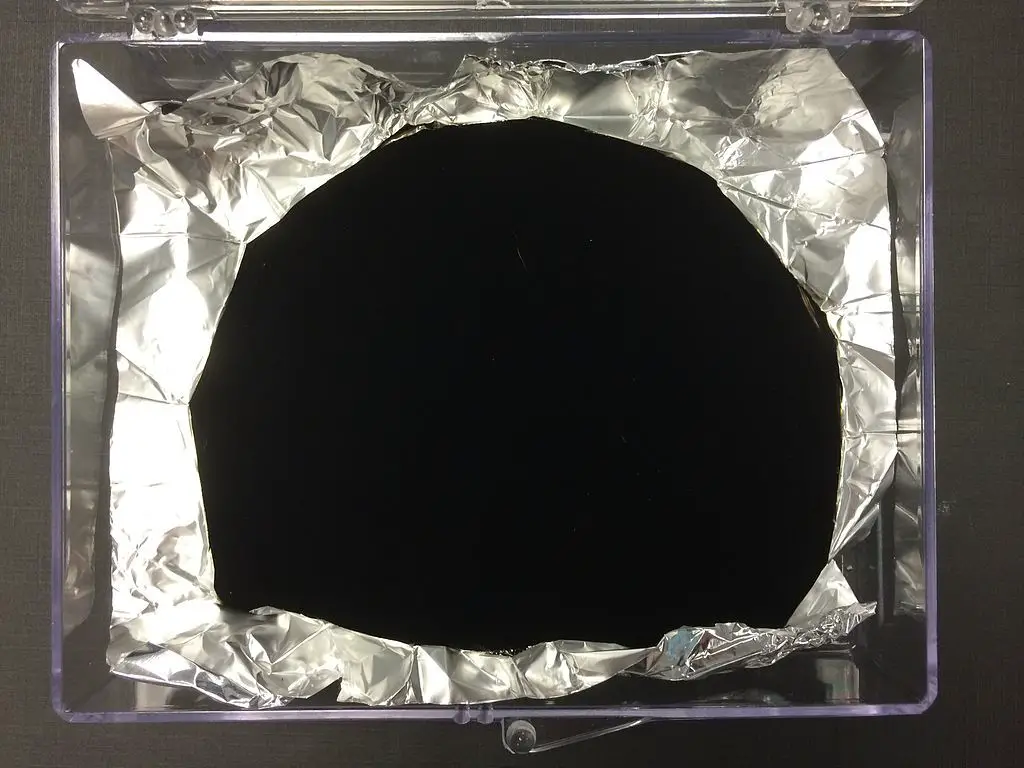Scientists in 2014 created the darkest commercially available material in the world called Vantablack. Then they bested themselves and made an even darker version. But in 2019, Vantablack was upended by a new material which became the blackest and darkest material in the world.
Vantablack was created by a British company called Surrey NanoSystems, and it originally absorbed all but 0.035% of visual light when it first came out in 2014. The company then developed a new version of Vantablack that could be sprayed directly onto other objects. This version was so black that there wasn’t an optical spectrometer (a device that measures the wavelength of light) available anywhere in the world with the sensitivity to test it. The material even absorbed light from a laser.
Vantablack is composed of millions of carbon nanotubes that are so small that each individual nanotube has a diameter of about 20 nanometers. That is 3,500 times smaller than the diameter of a human hair. When light hits the surface of the Vantablack, it enters the space between the millions of nanotubes. As light moves within the nanotube structure, it gets absorbed and can’t be reflected. This results in a black surface that comes as close as we know to what a black hole would look like since it reflects almost no light. It’s believed that one square centimeter of the surface holds one billion nanotubes, according to Surrey NanoSystems.
The appearance of Vantablack produces dramatic effects since there is almost no reflection from light. When it is put on a three-dimensional object, the object actually appears to be two-dimensional. Since Vantablack coats another surface, it’s almost impossible to see what the surface looks like. Any folds or creases on a surface appear flat or as if nothing is there. The human eye is unable to detect any surface changes without the reflection of light.
Vantablack is made through a process in a chemical vapor deposition chamber that uses lamps to increase the temperature of the surface to 430º Celsius. According to Surrey NanoSystems, this allows a carbon “nanotube forest to grow,” and the name derives from the term Vertically Aligned NanoTube Arrays. Of course, it’s much more complicated than that.
Vantablack can be used for many applications where light is not wanted. Some examples the company gives for its use include sensors, satellite calibration, infrared cameras, and luxury products. It’s even being tested in the world of art. Here’s a video of it in action.
But that’s not the end of the story of who has produced the darkest material in the world. In September 2019, engineers at the Massachusetts Institute of Technology (MIT), led by Brian Wardle and Kehang Cui, produced a material that was ten times blacker than any material before, namely Vantablack.
This material was also made of carbon nanotubes, but the difference with the MIT researchers’ material as compared with Vantablack, is that it was grown on chlorine-etched aluminum foil.
The MIT team hadn’t set out to produce a darker material than what had come before. They were actually trying to grow carbon nanotubes on aluminum foil to improve the aluminum’s thermal and electrical conduction properties. The problem, however, was that the foil would oxidize quickly when exposed to air, negating what they were trying to achieve.
To counteract the oxidation process, the team placed the foil in salt water and then moved it into an oven to grow the carbon nanotubes. What resulted was what they wanted. A material that had better electrical and thermal properties than before, but what else they noticed was that the new material was very, very black. After measuring the reflectance of the material, they discovered that it absorbed about 99.995% of the light hitting it, making it even darker and blacker than Vantablack.
Wardle and Chi applied for a patent on their new process and made it free for artists to use in noncommercial projects. Only time will tell who comes up with an even darker material that is even more black than what has currently been produced, something that even these researchers believe will happen.
Sources: Mirror Online, Science Alert, Business Insider, Surrey NanoSystems, Yahoo! News Canada, MIT News


